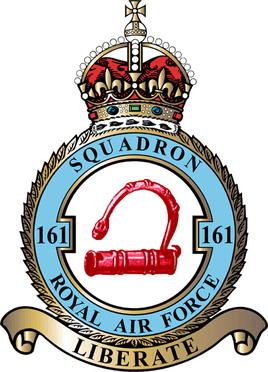No. 161 Squadron RAF facts for kids
Quick facts for kids No. 161 Squadron RAF |
|
|---|---|
 |
|
| Active | 9 May 1918 - 17 August 1918 15 February 1942 – 2 June 1945 |
| Country | |
| Branch | |
| Motto(s) | Liberate |
| Insignia | |
| Squadron badge heraldry | An open fetterlock |
| Squadron codes | MA Feb 1942 - 1945 JR Apr 1944 - 1945 (Lysander Flight only) |
No. 161 (Special Duties) Squadron was a very secret part of the Royal Air Force during Second World War. This special group of pilots and planes helped with secret missions. Their main job was to drop off and pick up secret agents and important equipment in places controlled by Nazi Germany. They also sometimes helped with the King's Flight, which flew important people.
History of No. 161 Squadron
No. 161 Squadron was created on February 15, 1942. It was formed at RAF Newmarket. The squadron was made up of planes and pilots from another group, 138 Squadron. It also included some planes and pilots from the King's Flight.
The first leader of the squadron was Edward Fielden. He was a very experienced pilot. The squadron had two main parts, called Flights. A Flight used six Lysander planes. Their job was to land and pick up agents. B Flight flew larger planes like Whitleys and Wellingtons. They would drop agents and supplies by parachute.
In April 1942, the squadron moved to RAF Tempsford in Bedfordshire. They stayed there for the rest of the war. Later, in November 1942, the Whitleys in B Flight were replaced with bigger, four-engine Halifax planes. After the war in Europe ended, the squadron was officially closed on June 2, 1945.
Aircraft Used by the Squadron
The squadron used several different types of aircraft for their important missions. Each plane had a special role.
- Westland Lysander: Used from February 1942 to November 1944.
- Armstrong Whitworth Whitley V: Used from February 1942 to December 1942.
- Havoc I: Used from February 1942 to December 1943.
- Handley Page Halifax B.Mk II: Used from September 1942 to December 1942.
- Armstrong Whitworth Albemarle: Used from October 1942 to April 1943.
- Handley Page Halifax B.Mk V: Used from November 1942 to November 1944.
- Lockheed Hudson III / V: Used from October 1943 to June 1945.
- Short Stirling III and IV: Used from September 1943 to June 1945.
The Lysander and Hudson planes were mainly used for landing and picking up secret agents. The other types of aircraft were used for dropping agents and supplies by parachute.


